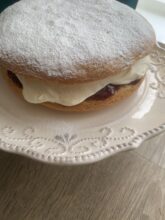VICTORIA SPONGE
Towards the end of the nineteenth century, ‘tea’ in England had strayed from being a minor liquid refreshment before bedtime to becoming the impressive spread of savory sandwiches, cookies and cakes, backed by the silver teapots and bone china cups that we equate with Victorian England. Victoria Sponge is its centerpiece, a sponge cake layered with raspberry jam (homemade of course) and often also with whipped cream. Technically the sponge is a pound cake, with the butter, sugar and flour weighing the same as the eggs, the only variable. Here Grandma is using three 2-ounce eggs.
Makes a 7-inch cake to serve 6
3 eggs, 2 oz/60 g each egg
¾ cup/180 g butter, more for the pans
¾ cup plus 2 tablespoons/180 g sugar, more for the pans
1 1/2 cups/180 g flour, more for the pans
1/1/2 teaspoons baking powder
1 teaspoon vanilla extract
1 cup/150 g raspberry or strawberry jam
To finish (optional)
1 cup/250 ml heavy cream, chilled
Confectioners’ sugar for the cream and for sprinkling the cake
Two 7-inch/18-cm cake pans
1. Heat the oven to 350ºF/180ºC and set a shelf near the center. Brush the cake pans with melted butter and line with rounds of parchment paper. Brush the paper with butter and sprinkle with sugar, discarding the excess. Flour the pans also, discarding the excess.
2. For the batter, sift the flour with the baking powder. Let the butter come to room temperature. Whisk it in an electric mixer until fluffy. Add the sugar and beat until soft and light, 2-3 minutes. Whisk the eggs until frothy in a separate bowl and gradually add them to the butter mixture, beating well after each addition. Add the vanilla with the last batch of egg, plus 1-2 tablespoons of the flour to prevent the batter separating. Finally fold in the remaining flour by hand in three batches, using a metal spoon. Divide the batter between the two prepared pans and spread it evenly, filling in the corners.
3. Bake the cakes in the heated oven, turning the pans once or twice so the batter rises and browns evenly. The cakes are done when evenly browned and starting to pull from the sides of the pan, 20-25 minutes; when pressed lightly in the center with your fingertip, the cakes should spring back. Transfer the pans to a rack to cool. After 5 minutes, unmold the cakes onto a rack lined with a clean dish towel, then turning them right side up onto another rack to cool completely so the tops are not marked with a lattice from the rack.
4. Shortly before serving, whisk the chilled cream until it stiffens and holds a soft peak. Sift over a tablespoon of confectioners’ sugar and continue whisking 10 seconds. Spread one cake with raspberry jam. Spread the cream on top using a palette knife and leaving a generous border of jam uncovered. Set the second cake on top, pressing it lightly down with the palm of your hand so whipped cream shows at the border of the cake. Sponge cakes like these are best eaten the day of baking, and they also keep well for a day or two in an airtight container.
5. Shortly before serving, sprinkle the top of the assembled cake generously with confectioners’ sugar. When serving, cut the cake in wedges with a bread knife.

